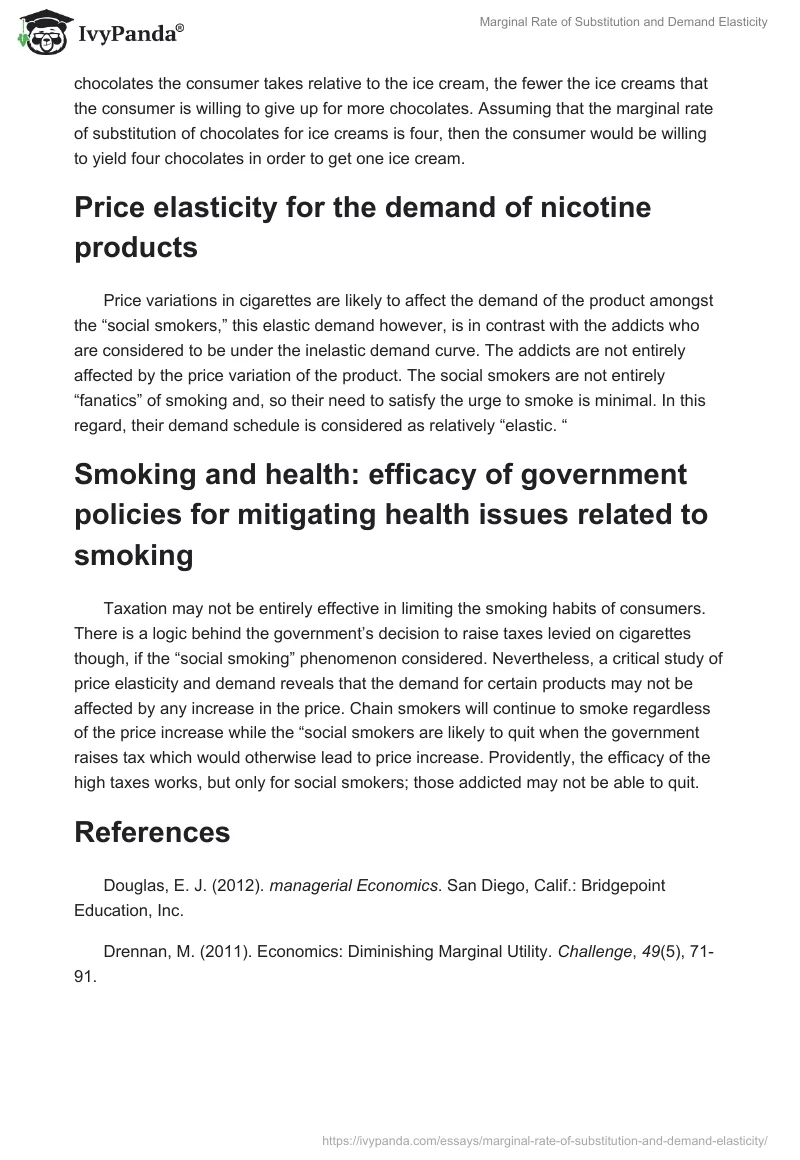Marginal rate of substitution
The idea of the marginal rate of substitution is an in-depth analysis of issues of opportunity cost in consumer behavior (Drennan, 2012). With several products in the market, consumers are incessantly faced with tough options over which products to consume and which ones to ignore. This aspect of taste preference is best quantified by the concept of marginal rate of substitution that mathematically expresses the measure of goods that a consumer is prepared to give up to pick a different good (Douglas, 2012).
Law of diminishing utility
The increment in consumption of a particular good or product, inherently leads to a reduction in the marginal utility of that product. An individual is likely to obtain reduced satisfaction from consuming a product repetitively. However, this reduction in the marginal utility is because the consumption of the other substitute product is constant. Conventionally, consumers are invariably willing to substitute away the goods or products that they frequently consume (Douglas, 2012).
Food consumption explains how the marginal utility of merchandise shrinks whenever the end user substitutes these products. For example, when one buys a glass of juice, the first glass is usually very enjoyable and fulfilling. However, the subsequent glasses will not be as enjoyable as the first glass, and so the consumer would be more willing to forego a glass of juice for another new product altogether. There is a general tendency for consumers to “tone down” their consumption of food in a “linear” manner. After the initial consumption, there is a decline in the preference.
Using the example of consumption of chocolates and ice creams, marginal utility can be obtained. Assuming that the marginal utility of chocolates and ice creams yield the same level of satisfaction to a consumer, margin utility, would depict that the more chocolates the consumer takes relative to the ice cream, the fewer the ice creams that the consumer is willing to give up for more chocolates. Assuming that the marginal rate of substitution of chocolates for ice creams is four, then the consumer would be willing to yield four chocolates in order to get one ice cream.
Price elasticity for the demand of nicotine products
Price variations in cigarettes are likely to affect the demand of the product amongst the “social smokers,” this elastic demand however, is in contrast with the addicts who are considered to be under the inelastic demand curve. The addicts are not entirely affected by the price variation of the product. The social smokers are not entirely “fanatics” of smoking and, so their need to satisfy the urge to smoke is minimal. In this regard, their demand schedule is considered as relatively “elastic. “
Smoking and health: efficacy of government policies for mitigating health issues related to smoking
Taxation may not be entirely effective in limiting the smoking habits of consumers. There is a logic behind the government’s decision to raise taxes levied on cigarettes though, if the “social smoking” phenomenon considered. Nevertheless, a critical study of price elasticity and demand reveals that the demand for certain products may not be affected by any increase in the price. Chain smokers will continue to smoke regardless of the price increase while the “social smokers are likely to quit when the government raises tax which would otherwise lead to price increase. Providently, the efficacy of the high taxes works, but only for social smokers; those addicted may not be able to quit.
References
Douglas, E. J. (2012). managerial Economics. San Diego, Calif.: Bridgepoint Education, Inc.
Drennan, M. (2011). Economics: Diminishing Marginal Utility. Challenge, 49(5), 71- 91.


